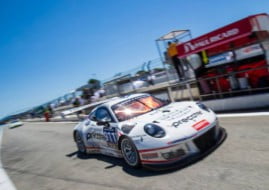The Glorious Spirit of Circuit Paul Ricard Lives On
Roughly in the same period when Martini adorned their cars with now iconic stripes, one more perfect cocktail that endures to this day was created. It was in 1969 when Paul Ricard built an eponymous track at Le Castellet near Marseille. The eccentric pastis maker wanted to see what it was like to build a highway, and he financed the construction of one of the safest and the most modern international tracks of its day.

Detail from the race at Circuit Paul Ricard
Probably the best circuit in France
Paul Ricard opened the 14-turn 5.809 km long Circuit a year later, in 1970. It hosted its first French Grand Prix in 1971, with Jackie Stewart winning in front of Francois Cevert and Emerson Fittipaldi. The last Grand Prix event took place in 1990 on a 9-turn 3.812 km long Club Circuit layout and the race was won by Alain Prost.

Map: Circuit Paul Ricard track layout
Three layouts at Paul Ricard Circuit
The track had three possible layouts, many facilities, and its own airstrip. The main straight of Circuit Paul Ricard was called Mistral. It was a 1.8km long before the kink was added, mostly for the safety reasons, because cars were often driven beyond their limits. It was followed by a right-hand corner called Signes, which came before two more famous bends, right-hand Beausset, and left-hand Bender.
Track suitable for record breaking performances
The layout of the track was quite suitable for many record-breaking performances, and one of the most notable ones was in 1985 when Marc Surer clocked his Brabham-BMW to 338 km/h, which was, at the time, the fastest any Formula 1 car ever went. The record for the long layout was made the same year when Keke Rosberg lapped it in 1:39.914. The short layout record is held by another man with a great mustache, Nigel Mansell who lapped the track in 1:08.012 in 1990.

Circuit Paul Ricard has an important place in history
Circuit Paul Ricard – From an F1 to a testing venue
After Paul Ricard passed away in 1997, the Circuit Paul Ricard was bought by Bernie Ecclestone’s company Exelis which rebuilt it. The circuit was converted into one of the most advanced testing tracks in the world. Circuit Paul Ricard is now called Paul Ricard High Tech Test Track and it is known for its runoff zones — the Blue Zone, consisting of asphalt and tungsten and the Red Zone, the deeper runoff zone which maximizes braking should the car lose control beyond the Blue Zone. If the red zone isn’t enough, Trepco barriers are the last safeguard for unlucky drivers who pushed the cars way beyond their limits.

WTCC race at Paul Ricard circuit
The glorious spirit of Circuit Paul Ricard still lives today. Though the track used to be a home to many legendary drivers and exciting races, its reinvented purpose is to test the limits of the future and bring it to today.

Aerial view of the Circuit Paul Ricard
Ready to return to the biggest stage
Late in 2016 was announced that the Formula 1 French Grand Prix is set to return on calendar for the first time since 2008. In June 2018, Circuit Paul Ricard hosted the race the race of the most popular motorsport championship for the first time since 1990.
This fact should be a big boost to the Circuit Paul Ricard to make further development and to establish itself as the most important racing venue in France.
Address: 2760 Route des Hauts du Camp, 83330 Le Castellet, France
Phone: +33 4 94 98 36 66
Website: circuitpaulricard.com







